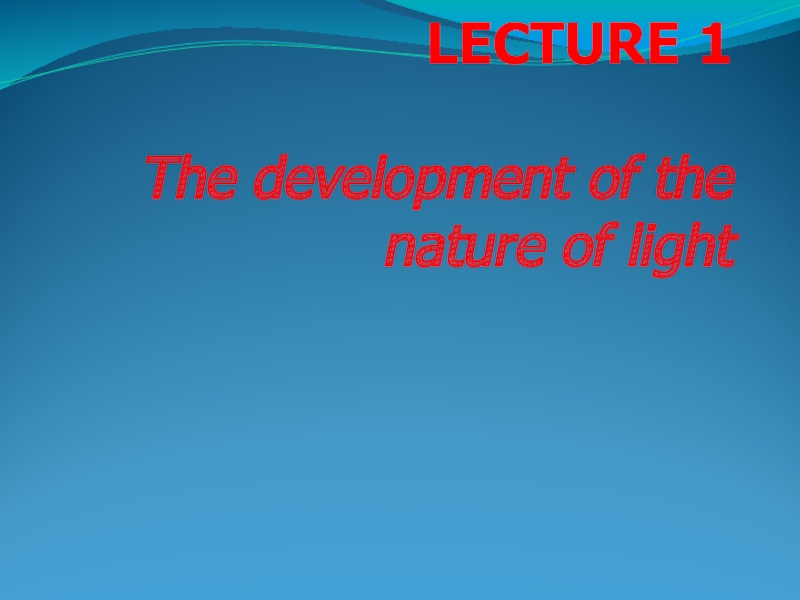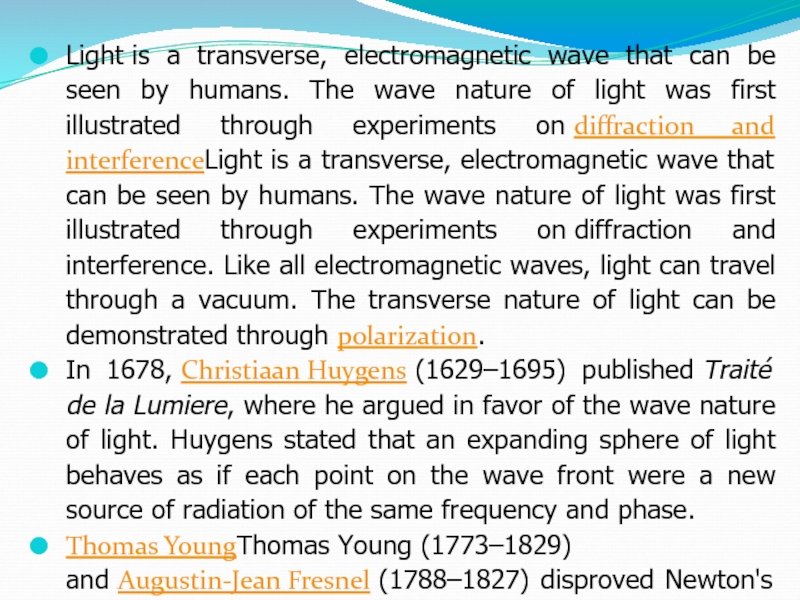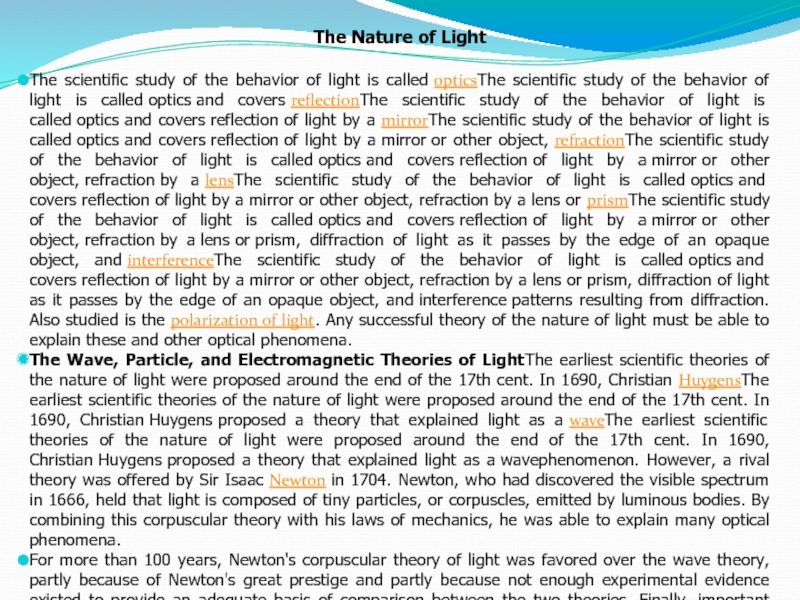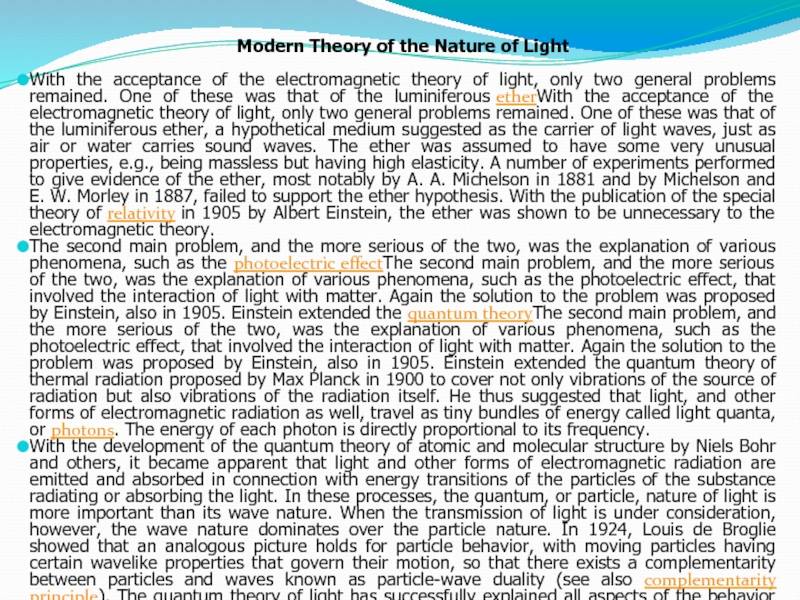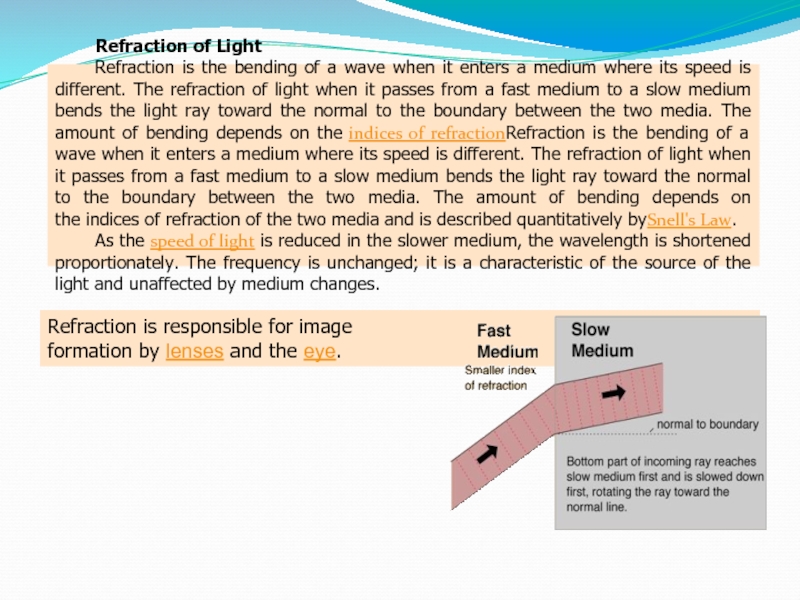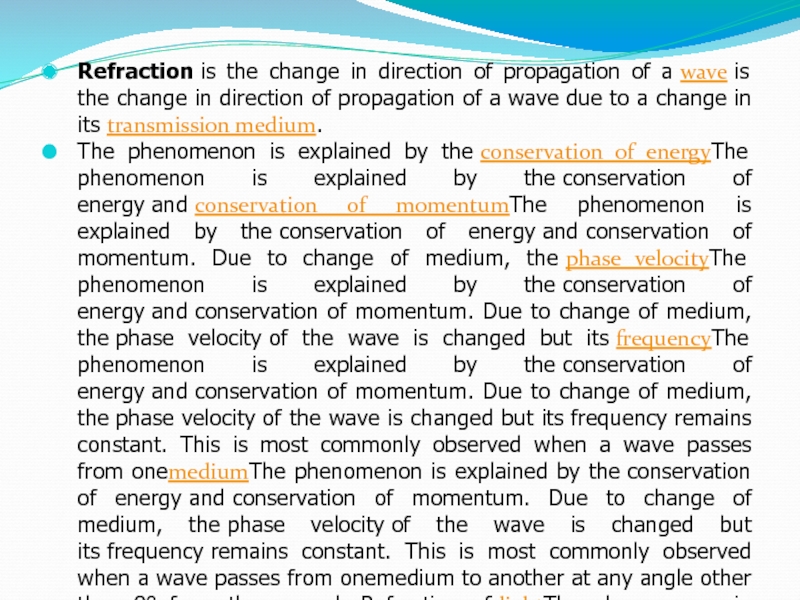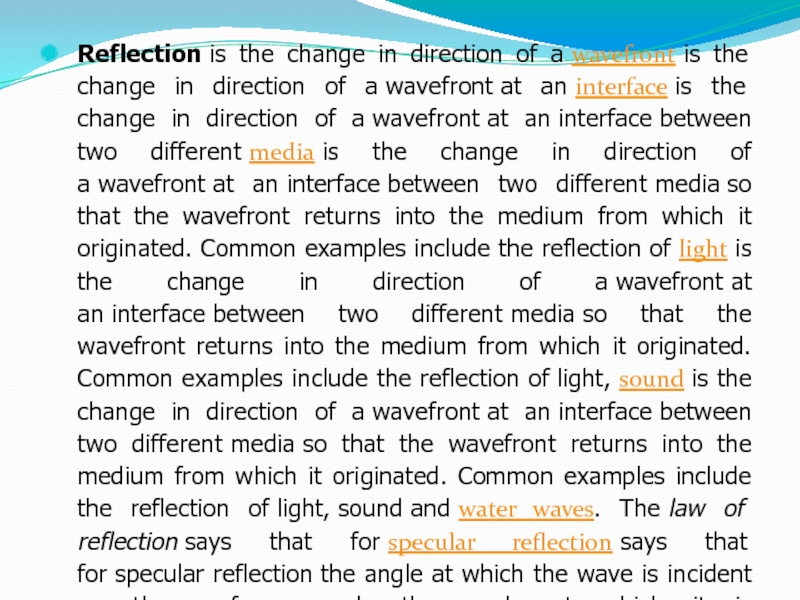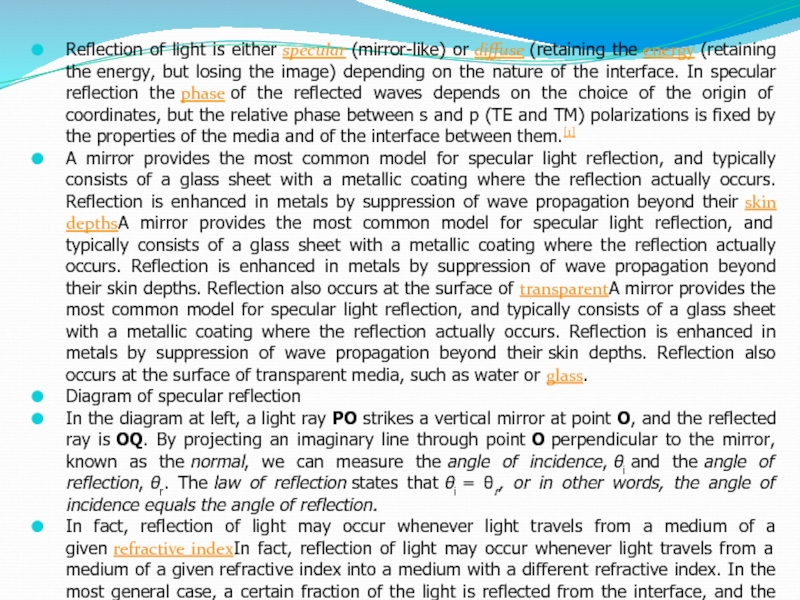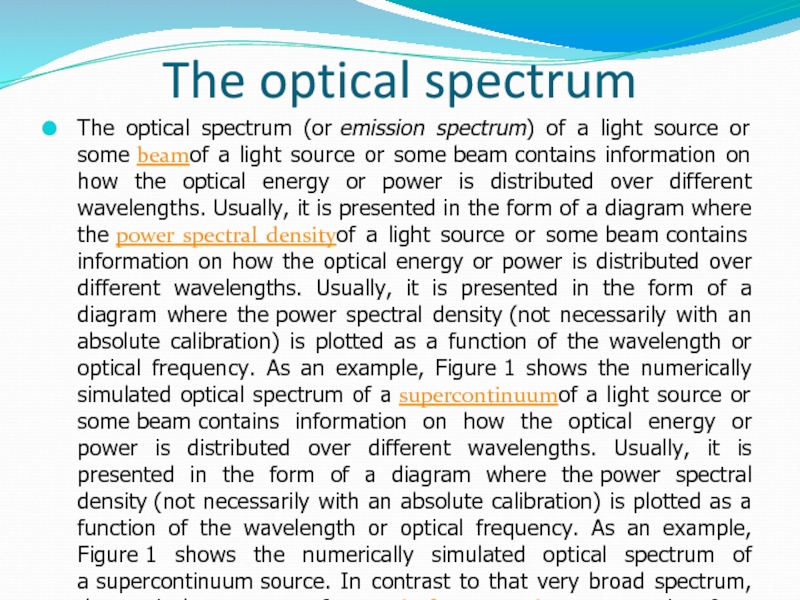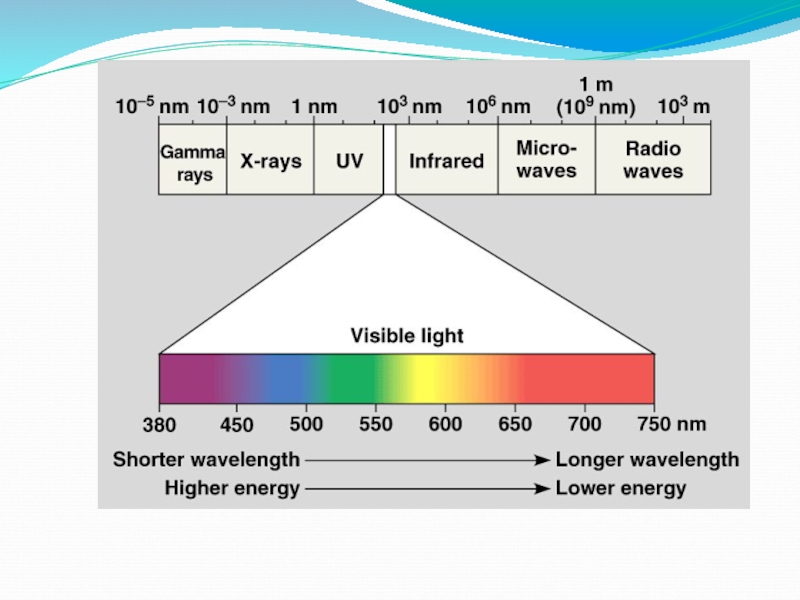- Главная
- Разное
- Дизайн
- Бизнес и предпринимательство
- Аналитика
- Образование
- Развлечения
- Красота и здоровье
- Финансы
- Государство
- Путешествия
- Спорт
- Недвижимость
- Армия
- Графика
- Культурология
- Еда и кулинария
- Лингвистика
- Английский язык
- Астрономия
- Алгебра
- Биология
- География
- Детские презентации
- Информатика
- История
- Литература
- Маркетинг
- Математика
- Медицина
- Менеджмент
- Музыка
- МХК
- Немецкий язык
- ОБЖ
- Обществознание
- Окружающий мир
- Педагогика
- Русский язык
- Технология
- Физика
- Философия
- Химия
- Шаблоны, картинки для презентаций
- Экология
- Экономика
- Юриспруденция
The development of the nature of light презентация
Содержание
- 1. The development of the nature of light
- 2. Light is a transverse, electromagnetic wave that can
- 3. The Nature of Light The scientific
- 4. Modern Theory of the Nature of Light
- 5. Refraction of Light Refraction is the bending
- 6. Refraction is the change in direction of propagation
- 7. Reflection is the change in direction of a wavefront is
- 8. Reflection of light is either specular (mirror-like) or diffuse (retaining the energy (retaining
- 9. The optical spectrum The optical spectrum (or emission
Слайд 2Light is a transverse, electromagnetic wave that can be seen by humans.
The wave nature of light was first illustrated through experiments on diffraction and interferenceLight is a transverse, electromagnetic wave that can be seen by humans. The wave nature of light was first illustrated through experiments on diffraction and interference. Like all electromagnetic waves, light can travel through a vacuum. The transverse nature of light can be demonstrated through polarization.
In 1678, Christiaan Huygens (1629–1695) published Traité de la Lumiere, where he argued in favor of the wave nature of light. Huygens stated that an expanding sphere of light behaves as if each point on the wave front were a new source of radiation of the same frequency and phase.
Thomas YoungThomas Young (1773–1829) and Augustin-Jean Fresnel (1788–1827) disproved Newton's corpuscular theory.
In 1678, Christiaan Huygens (1629–1695) published Traité de la Lumiere, where he argued in favor of the wave nature of light. Huygens stated that an expanding sphere of light behaves as if each point on the wave front were a new source of radiation of the same frequency and phase.
Thomas YoungThomas Young (1773–1829) and Augustin-Jean Fresnel (1788–1827) disproved Newton's corpuscular theory.
Слайд 3The Nature of Light
The scientific study of the behavior of light
is called opticsThe scientific study of the behavior of light is called optics and covers reflectionThe scientific study of the behavior of light is called optics and covers reflection of light by a mirrorThe scientific study of the behavior of light is called optics and covers reflection of light by a mirror or other object, refractionThe scientific study of the behavior of light is called optics and covers reflection of light by a mirror or other object, refraction by a lensThe scientific study of the behavior of light is called optics and covers reflection of light by a mirror or other object, refraction by a lens or prismThe scientific study of the behavior of light is called optics and covers reflection of light by a mirror or other object, refraction by a lens or prism, diffraction of light as it passes by the edge of an opaque object, and interferenceThe scientific study of the behavior of light is called optics and covers reflection of light by a mirror or other object, refraction by a lens or prism, diffraction of light as it passes by the edge of an opaque object, and interference patterns resulting from diffraction. Also studied is the polarization of light. Any successful theory of the nature of light must be able to explain these and other optical phenomena.
The Wave, Particle, and Electromagnetic Theories of LightThe earliest scientific theories of the nature of light were proposed around the end of the 17th cent. In 1690, Christian HuygensThe earliest scientific theories of the nature of light were proposed around the end of the 17th cent. In 1690, Christian Huygens proposed a theory that explained light as a waveThe earliest scientific theories of the nature of light were proposed around the end of the 17th cent. In 1690, Christian Huygens proposed a theory that explained light as a wavephenomenon. However, a rival theory was offered by Sir Isaac Newton in 1704. Newton, who had discovered the visible spectrum in 1666, held that light is composed of tiny particles, or corpuscles, emitted by luminous bodies. By combining this corpuscular theory with his laws of mechanics, he was able to explain many optical phenomena.
For more than 100 years, Newton's corpuscular theory of light was favored over the wave theory, partly because of Newton's great prestige and partly because not enough experimental evidence existed to provide an adequate basis of comparison between the two theories. Finally, important experiments were done on the diffraction and interferenceFor more than 100 years, Newton's corpuscular theory of light was favored over the wave theory, partly because of Newton's great prestige and partly because not enough experimental evidence existed to provide an adequate basis of comparison between the two theories. Finally, important experiments were done on the diffraction and interferenceof light by Thomas Young (1801) and A. J. Fresnel (1814–15) that could only be interpreted in terms of the wave theory. The polarization of light was still another phenomenon that could only be explained by the wave theory. Thus, in the 19th cent. the wave theory became the dominant theory of the nature of light.
The wave theory received additional support from the electromagnetic theory of James Clerk Maxwell (1864), who showed that electric and magnetic fields were propagated together and that their speed was identical with the speed of light. It thus became clear that visible light is a form of electromagnetic radiation, constituting only a small part of the electromagnetic spectrum. Maxwell's theory was confirmed experimentally with the discovery of radio waves by Heinrich Hertz in 1886.
The Wave, Particle, and Electromagnetic Theories of LightThe earliest scientific theories of the nature of light were proposed around the end of the 17th cent. In 1690, Christian HuygensThe earliest scientific theories of the nature of light were proposed around the end of the 17th cent. In 1690, Christian Huygens proposed a theory that explained light as a waveThe earliest scientific theories of the nature of light were proposed around the end of the 17th cent. In 1690, Christian Huygens proposed a theory that explained light as a wavephenomenon. However, a rival theory was offered by Sir Isaac Newton in 1704. Newton, who had discovered the visible spectrum in 1666, held that light is composed of tiny particles, or corpuscles, emitted by luminous bodies. By combining this corpuscular theory with his laws of mechanics, he was able to explain many optical phenomena.
For more than 100 years, Newton's corpuscular theory of light was favored over the wave theory, partly because of Newton's great prestige and partly because not enough experimental evidence existed to provide an adequate basis of comparison between the two theories. Finally, important experiments were done on the diffraction and interferenceFor more than 100 years, Newton's corpuscular theory of light was favored over the wave theory, partly because of Newton's great prestige and partly because not enough experimental evidence existed to provide an adequate basis of comparison between the two theories. Finally, important experiments were done on the diffraction and interferenceof light by Thomas Young (1801) and A. J. Fresnel (1814–15) that could only be interpreted in terms of the wave theory. The polarization of light was still another phenomenon that could only be explained by the wave theory. Thus, in the 19th cent. the wave theory became the dominant theory of the nature of light.
The wave theory received additional support from the electromagnetic theory of James Clerk Maxwell (1864), who showed that electric and magnetic fields were propagated together and that their speed was identical with the speed of light. It thus became clear that visible light is a form of electromagnetic radiation, constituting only a small part of the electromagnetic spectrum. Maxwell's theory was confirmed experimentally with the discovery of radio waves by Heinrich Hertz in 1886.
Слайд 4Modern Theory of the Nature of Light
With the acceptance of the
electromagnetic theory of light, only two general problems remained. One of these was that of the luminiferous etherWith the acceptance of the electromagnetic theory of light, only two general problems remained. One of these was that of the luminiferous ether, a hypothetical medium suggested as the carrier of light waves, just as air or water carries sound waves. The ether was assumed to have some very unusual properties, e.g., being massless but having high elasticity. A number of experiments performed to give evidence of the ether, most notably by A. A. Michelson in 1881 and by Michelson and E. W. Morley in 1887, failed to support the ether hypothesis. With the publication of the special theory of relativity in 1905 by Albert Einstein, the ether was shown to be unnecessary to the electromagnetic theory.
The second main problem, and the more serious of the two, was the explanation of various phenomena, such as the photoelectric effectThe second main problem, and the more serious of the two, was the explanation of various phenomena, such as the photoelectric effect, that involved the interaction of light with matter. Again the solution to the problem was proposed by Einstein, also in 1905. Einstein extended the quantum theoryThe second main problem, and the more serious of the two, was the explanation of various phenomena, such as the photoelectric effect, that involved the interaction of light with matter. Again the solution to the problem was proposed by Einstein, also in 1905. Einstein extended the quantum theory of thermal radiation proposed by Max Planck in 1900 to cover not only vibrations of the source of radiation but also vibrations of the radiation itself. He thus suggested that light, and other forms of electromagnetic radiation as well, travel as tiny bundles of energy called light quanta, or photons. The energy of each photon is directly proportional to its frequency.
With the development of the quantum theory of atomic and molecular structure by Niels Bohr and others, it became apparent that light and other forms of electromagnetic radiation are emitted and absorbed in connection with energy transitions of the particles of the substance radiating or absorbing the light. In these processes, the quantum, or particle, nature of light is more important than its wave nature. When the transmission of light is under consideration, however, the wave nature dominates over the particle nature. In 1924, Louis de Broglie showed that an analogous picture holds for particle behavior, with moving particles having certain wavelike properties that govern their motion, so that there exists a complementarity between particles and waves known as particle-wave duality (see also complementarity principle). The quantum theory of light has successfully explained all aspects of the behavior of light.
The second main problem, and the more serious of the two, was the explanation of various phenomena, such as the photoelectric effectThe second main problem, and the more serious of the two, was the explanation of various phenomena, such as the photoelectric effect, that involved the interaction of light with matter. Again the solution to the problem was proposed by Einstein, also in 1905. Einstein extended the quantum theoryThe second main problem, and the more serious of the two, was the explanation of various phenomena, such as the photoelectric effect, that involved the interaction of light with matter. Again the solution to the problem was proposed by Einstein, also in 1905. Einstein extended the quantum theory of thermal radiation proposed by Max Planck in 1900 to cover not only vibrations of the source of radiation but also vibrations of the radiation itself. He thus suggested that light, and other forms of electromagnetic radiation as well, travel as tiny bundles of energy called light quanta, or photons. The energy of each photon is directly proportional to its frequency.
With the development of the quantum theory of atomic and molecular structure by Niels Bohr and others, it became apparent that light and other forms of electromagnetic radiation are emitted and absorbed in connection with energy transitions of the particles of the substance radiating or absorbing the light. In these processes, the quantum, or particle, nature of light is more important than its wave nature. When the transmission of light is under consideration, however, the wave nature dominates over the particle nature. In 1924, Louis de Broglie showed that an analogous picture holds for particle behavior, with moving particles having certain wavelike properties that govern their motion, so that there exists a complementarity between particles and waves known as particle-wave duality (see also complementarity principle). The quantum theory of light has successfully explained all aspects of the behavior of light.
Слайд 5Refraction of Light
Refraction is the bending of a wave when it
enters a medium where its speed is different. The refraction of light when it passes from a fast medium to a slow medium bends the light ray toward the normal to the boundary between the two media. The amount of bending depends on the indices of refractionRefraction is the bending of a wave when it enters a medium where its speed is different. The refraction of light when it passes from a fast medium to a slow medium bends the light ray toward the normal to the boundary between the two media. The amount of bending depends on the indices of refraction of the two media and is described quantitatively bySnell's Law.
As the speed of light is reduced in the slower medium, the wavelength is shortened proportionately. The frequency is unchanged; it is a characteristic of the source of the light and unaffected by medium changes.
As the speed of light is reduced in the slower medium, the wavelength is shortened proportionately. The frequency is unchanged; it is a characteristic of the source of the light and unaffected by medium changes.
Слайд 6Refraction is the change in direction of propagation of a wave is the change
in direction of propagation of a wave due to a change in its transmission medium.
The phenomenon is explained by the conservation of energyThe phenomenon is explained by the conservation of energy and conservation of momentumThe phenomenon is explained by the conservation of energy and conservation of momentum. Due to change of medium, the phase velocityThe phenomenon is explained by the conservation of energy and conservation of momentum. Due to change of medium, the phase velocity of the wave is changed but its frequencyThe phenomenon is explained by the conservation of energy and conservation of momentum. Due to change of medium, the phase velocity of the wave is changed but its frequency remains constant. This is most commonly observed when a wave passes from onemediumThe phenomenon is explained by the conservation of energy and conservation of momentum. Due to change of medium, the phase velocity of the wave is changed but its frequency remains constant. This is most commonly observed when a wave passes from onemedium to another at any angle other than 0° from the normal. Refraction of lightThe phenomenon is explained by the conservation of energy and conservation of momentum. Due to change of medium, the phase velocity of the wave is changed but its frequency remains constant. This is most commonly observed when a wave passes from onemedium to another at any angle other than 0° from the normal. Refraction of light is the most commonly observed phenomenon, but any type of wave can refract when it interacts with a medium, for example when sound wavesThe phenomenon is explained by the conservation of energy and conservation of momentum. Due to change of medium, the phase velocity of the wave is changed but its frequency remains constant. This is most commonly observed when a wave passes from onemedium to another at any angle other than 0° from the normal. Refraction of light is the most commonly observed phenomenon, but any type of wave can refract when it interacts with a medium, for example when sound waves pass from one medium into another or when water waves move into water of a different depth. Refraction is described by Snell's lawThe phenomenon is explained by the conservation of energy and conservation of momentum. Due to change of medium, the phase velocity of the wave is changed but its frequency remains constant. This is most commonly observed when a wave passes from onemedium to another at any angle other than 0° from the normal. Refraction of light is the most commonly observed phenomenon, but any type of wave can refract when it interacts with a medium, for example when sound waves pass from one medium into another or when water waves move into water of a different depth. Refraction is described by Snell's law, which states that for a given pair of media and a wave with a single frequency, the ratio of the sines of the angle of incidence θ1 and angle of refraction θ2 is equivalent to the ratio of phase velocities (v1 / v2) in the two media, or equivalently, to the opposite ratio of the indices of refraction (n2 / n1):
The phenomenon is explained by the conservation of energyThe phenomenon is explained by the conservation of energy and conservation of momentumThe phenomenon is explained by the conservation of energy and conservation of momentum. Due to change of medium, the phase velocityThe phenomenon is explained by the conservation of energy and conservation of momentum. Due to change of medium, the phase velocity of the wave is changed but its frequencyThe phenomenon is explained by the conservation of energy and conservation of momentum. Due to change of medium, the phase velocity of the wave is changed but its frequency remains constant. This is most commonly observed when a wave passes from onemediumThe phenomenon is explained by the conservation of energy and conservation of momentum. Due to change of medium, the phase velocity of the wave is changed but its frequency remains constant. This is most commonly observed when a wave passes from onemedium to another at any angle other than 0° from the normal. Refraction of lightThe phenomenon is explained by the conservation of energy and conservation of momentum. Due to change of medium, the phase velocity of the wave is changed but its frequency remains constant. This is most commonly observed when a wave passes from onemedium to another at any angle other than 0° from the normal. Refraction of light is the most commonly observed phenomenon, but any type of wave can refract when it interacts with a medium, for example when sound wavesThe phenomenon is explained by the conservation of energy and conservation of momentum. Due to change of medium, the phase velocity of the wave is changed but its frequency remains constant. This is most commonly observed when a wave passes from onemedium to another at any angle other than 0° from the normal. Refraction of light is the most commonly observed phenomenon, but any type of wave can refract when it interacts with a medium, for example when sound waves pass from one medium into another or when water waves move into water of a different depth. Refraction is described by Snell's lawThe phenomenon is explained by the conservation of energy and conservation of momentum. Due to change of medium, the phase velocity of the wave is changed but its frequency remains constant. This is most commonly observed when a wave passes from onemedium to another at any angle other than 0° from the normal. Refraction of light is the most commonly observed phenomenon, but any type of wave can refract when it interacts with a medium, for example when sound waves pass from one medium into another or when water waves move into water of a different depth. Refraction is described by Snell's law, which states that for a given pair of media and a wave with a single frequency, the ratio of the sines of the angle of incidence θ1 and angle of refraction θ2 is equivalent to the ratio of phase velocities (v1 / v2) in the two media, or equivalently, to the opposite ratio of the indices of refraction (n2 / n1):
Слайд 7Reflection is the change in direction of a wavefront is the change in direction
of a wavefront at an interface is the change in direction of a wavefront at an interface between two different media is the change in direction of a wavefront at an interface between two different media so that the wavefront returns into the medium from which it originated. Common examples include the reflection of light is the change in direction of a wavefront at an interface between two different media so that the wavefront returns into the medium from which it originated. Common examples include the reflection of light, sound is the change in direction of a wavefront at an interface between two different media so that the wavefront returns into the medium from which it originated. Common examples include the reflection of light, sound and water waves. The law of reflection says that for specular reflection says that for specular reflection the angle at which the wave is incident on the surface equals the angle at which it is reflected. Mirrors exhibit specular reflection.
In acousticsIn acoustics, reflection causes echoesIn acoustics, reflection causes echoes and is used in sonarIn acoustics, reflection causes echoes and is used in sonar. In geology, it is important in the study of seismic wavesIn acoustics, reflection causes echoes and is used in sonar. In geology, it is important in the study of seismic waves. Reflection is observed with surface wavesIn acoustics, reflection causes echoes and is used in sonar. In geology, it is important in the study of seismic waves. Reflection is observed with surface waves in bodies of water. Reflection is observed with many types of electromagnetic waveIn acoustics, reflection causes echoes and is used in sonar. In geology, it is important in the study of seismic waves. Reflection is observed with surface waves in bodies of water. Reflection is observed with many types of electromagnetic wave, besides visible lightIn acoustics, reflection causes echoes and is used in sonar. In geology, it is important in the study of seismic waves. Reflection is observed with surface waves in bodies of water. Reflection is observed with many types of electromagnetic wave, besides visible light. Reflection of VHFIn acoustics, reflection causes echoes and is used in sonar. In geology, it is important in the study of seismic waves. Reflection is observed with surface waves in bodies of water. Reflection is observed with many types of electromagnetic wave, besides visible light. Reflection of VHF and higher frequencies is important for radioIn acoustics, reflection causes echoes and is used in sonar. In geology, it is important in the study of seismic waves. Reflection is observed with surface waves in bodies of water. Reflection is observed with many types of electromagnetic wave, besides visible light. Reflection of VHF and higher frequencies is important for radio transmission and for radarIn acoustics, reflection causes echoes and is used in sonar. In geology, it is important in the study of seismic waves. Reflection is observed with surface waves in bodies of water. Reflection is observed with many types of electromagnetic wave, besides visible light. Reflection of VHF and higher frequencies is important for radio transmission and for radar. Even hard X-raysIn acoustics, reflection causes echoes and is used in sonar. In geology, it is important in the study of seismic waves. Reflection is observed with surface waves in bodies of water. Reflection is observed with many types of electromagnetic wave, besides visible light. Reflection of VHF and higher frequencies is important for radio transmission and for radar. Even hard X-rays and gamma rays can be reflected at shallow angles with special "grazing" mirrors.
In acousticsIn acoustics, reflection causes echoesIn acoustics, reflection causes echoes and is used in sonarIn acoustics, reflection causes echoes and is used in sonar. In geology, it is important in the study of seismic wavesIn acoustics, reflection causes echoes and is used in sonar. In geology, it is important in the study of seismic waves. Reflection is observed with surface wavesIn acoustics, reflection causes echoes and is used in sonar. In geology, it is important in the study of seismic waves. Reflection is observed with surface waves in bodies of water. Reflection is observed with many types of electromagnetic waveIn acoustics, reflection causes echoes and is used in sonar. In geology, it is important in the study of seismic waves. Reflection is observed with surface waves in bodies of water. Reflection is observed with many types of electromagnetic wave, besides visible lightIn acoustics, reflection causes echoes and is used in sonar. In geology, it is important in the study of seismic waves. Reflection is observed with surface waves in bodies of water. Reflection is observed with many types of electromagnetic wave, besides visible light. Reflection of VHFIn acoustics, reflection causes echoes and is used in sonar. In geology, it is important in the study of seismic waves. Reflection is observed with surface waves in bodies of water. Reflection is observed with many types of electromagnetic wave, besides visible light. Reflection of VHF and higher frequencies is important for radioIn acoustics, reflection causes echoes and is used in sonar. In geology, it is important in the study of seismic waves. Reflection is observed with surface waves in bodies of water. Reflection is observed with many types of electromagnetic wave, besides visible light. Reflection of VHF and higher frequencies is important for radio transmission and for radarIn acoustics, reflection causes echoes and is used in sonar. In geology, it is important in the study of seismic waves. Reflection is observed with surface waves in bodies of water. Reflection is observed with many types of electromagnetic wave, besides visible light. Reflection of VHF and higher frequencies is important for radio transmission and for radar. Even hard X-raysIn acoustics, reflection causes echoes and is used in sonar. In geology, it is important in the study of seismic waves. Reflection is observed with surface waves in bodies of water. Reflection is observed with many types of electromagnetic wave, besides visible light. Reflection of VHF and higher frequencies is important for radio transmission and for radar. Even hard X-rays and gamma rays can be reflected at shallow angles with special "grazing" mirrors.
Слайд 8Reflection of light is either specular (mirror-like) or diffuse (retaining the energy (retaining the energy, but losing the
image) depending on the nature of the interface. In specular reflection the phase of the reflected waves depends on the choice of the origin of coordinates, but the relative phase between s and p (TE and TM) polarizations is fixed by the properties of the media and of the interface between them.[1]
A mirror provides the most common model for specular light reflection, and typically consists of a glass sheet with a metallic coating where the reflection actually occurs. Reflection is enhanced in metals by suppression of wave propagation beyond their skin depthsA mirror provides the most common model for specular light reflection, and typically consists of a glass sheet with a metallic coating where the reflection actually occurs. Reflection is enhanced in metals by suppression of wave propagation beyond their skin depths. Reflection also occurs at the surface of transparentA mirror provides the most common model for specular light reflection, and typically consists of a glass sheet with a metallic coating where the reflection actually occurs. Reflection is enhanced in metals by suppression of wave propagation beyond their skin depths. Reflection also occurs at the surface of transparent media, such as water or glass.
Diagram of specular reflection
In the diagram at left, a light ray PO strikes a vertical mirror at point O, and the reflected ray is OQ. By projecting an imaginary line through point O perpendicular to the mirror, known as the normal, we can measure the angle of incidence, θi and the angle of reflection, θr. The law of reflection states that θi = θr, or in other words, the angle of incidence equals the angle of reflection.
In fact, reflection of light may occur whenever light travels from a medium of a given refractive indexIn fact, reflection of light may occur whenever light travels from a medium of a given refractive index into a medium with a different refractive index. In the most general case, a certain fraction of the light is reflected from the interface, and the remainder is refractedIn fact, reflection of light may occur whenever light travels from a medium of a given refractive index into a medium with a different refractive index. In the most general case, a certain fraction of the light is reflected from the interface, and the remainder is refracted. Solving Maxwell's equationsIn fact, reflection of light may occur whenever light travels from a medium of a given refractive index into a medium with a different refractive index. In the most general case, a certain fraction of the light is reflected from the interface, and the remainder is refracted. Solving Maxwell's equations for a light ray striking a boundary allows the derivation of the Fresnel equationsIn fact, reflection of light may occur whenever light travels from a medium of a given refractive index into a medium with a different refractive index. In the most general case, a certain fraction of the light is reflected from the interface, and the remainder is refracted. Solving Maxwell's equations for a light ray striking a boundary allows the derivation of the Fresnel equations, which can be used to predict how much of the light is reflected, and how much is refracted in a given situation. This is analogous to the way impedance mismatchIn fact, reflection of light may occur whenever light travels from a medium of a given refractive index into a medium with a different refractive index. In the most general case, a certain fraction of the light is reflected from the interface, and the remainder is refracted. Solving Maxwell's equations for a light ray striking a boundary allows the derivation of the Fresnel equations, which can be used to predict how much of the light is reflected, and how much is refracted in a given situation. This is analogous to the way impedance mismatch in an electric circuit causes reflection of signals. Total internal reflectionIn fact, reflection of light may occur whenever light travels from a medium of a given refractive index into a medium with a different refractive index. In the most general case, a certain fraction of the light is reflected from the interface, and the remainder is refracted. Solving Maxwell's equations for a light ray striking a boundary allows the derivation of the Fresnel equations, which can be used to predict how much of the light is reflected, and how much is refracted in a given situation. This is analogous to the way impedance mismatch in an electric circuit causes reflection of signals. Total internal reflection of light from a denser medium occurs if the angle of incidence is above the critical angle.
A mirror provides the most common model for specular light reflection, and typically consists of a glass sheet with a metallic coating where the reflection actually occurs. Reflection is enhanced in metals by suppression of wave propagation beyond their skin depthsA mirror provides the most common model for specular light reflection, and typically consists of a glass sheet with a metallic coating where the reflection actually occurs. Reflection is enhanced in metals by suppression of wave propagation beyond their skin depths. Reflection also occurs at the surface of transparentA mirror provides the most common model for specular light reflection, and typically consists of a glass sheet with a metallic coating where the reflection actually occurs. Reflection is enhanced in metals by suppression of wave propagation beyond their skin depths. Reflection also occurs at the surface of transparent media, such as water or glass.
Diagram of specular reflection
In the diagram at left, a light ray PO strikes a vertical mirror at point O, and the reflected ray is OQ. By projecting an imaginary line through point O perpendicular to the mirror, known as the normal, we can measure the angle of incidence, θi and the angle of reflection, θr. The law of reflection states that θi = θr, or in other words, the angle of incidence equals the angle of reflection.
In fact, reflection of light may occur whenever light travels from a medium of a given refractive indexIn fact, reflection of light may occur whenever light travels from a medium of a given refractive index into a medium with a different refractive index. In the most general case, a certain fraction of the light is reflected from the interface, and the remainder is refractedIn fact, reflection of light may occur whenever light travels from a medium of a given refractive index into a medium with a different refractive index. In the most general case, a certain fraction of the light is reflected from the interface, and the remainder is refracted. Solving Maxwell's equationsIn fact, reflection of light may occur whenever light travels from a medium of a given refractive index into a medium with a different refractive index. In the most general case, a certain fraction of the light is reflected from the interface, and the remainder is refracted. Solving Maxwell's equations for a light ray striking a boundary allows the derivation of the Fresnel equationsIn fact, reflection of light may occur whenever light travels from a medium of a given refractive index into a medium with a different refractive index. In the most general case, a certain fraction of the light is reflected from the interface, and the remainder is refracted. Solving Maxwell's equations for a light ray striking a boundary allows the derivation of the Fresnel equations, which can be used to predict how much of the light is reflected, and how much is refracted in a given situation. This is analogous to the way impedance mismatchIn fact, reflection of light may occur whenever light travels from a medium of a given refractive index into a medium with a different refractive index. In the most general case, a certain fraction of the light is reflected from the interface, and the remainder is refracted. Solving Maxwell's equations for a light ray striking a boundary allows the derivation of the Fresnel equations, which can be used to predict how much of the light is reflected, and how much is refracted in a given situation. This is analogous to the way impedance mismatch in an electric circuit causes reflection of signals. Total internal reflectionIn fact, reflection of light may occur whenever light travels from a medium of a given refractive index into a medium with a different refractive index. In the most general case, a certain fraction of the light is reflected from the interface, and the remainder is refracted. Solving Maxwell's equations for a light ray striking a boundary allows the derivation of the Fresnel equations, which can be used to predict how much of the light is reflected, and how much is refracted in a given situation. This is analogous to the way impedance mismatch in an electric circuit causes reflection of signals. Total internal reflection of light from a denser medium occurs if the angle of incidence is above the critical angle.
Слайд 9The optical spectrum
The optical spectrum (or emission spectrum) of a light source
or some beamof a light source or some beam contains information on how the optical energy or power is distributed over different wavelengths. Usually, it is presented in the form of a diagram where the power spectral densityof a light source or some beam contains information on how the optical energy or power is distributed over different wavelengths. Usually, it is presented in the form of a diagram where the power spectral density (not necessarily with an absolute calibration) is plotted as a function of the wavelength or optical frequency. As an example, Figure 1 shows the numerically simulated optical spectrum of a supercontinuumof a light source or some beam contains information on how the optical energy or power is distributed over different wavelengths. Usually, it is presented in the form of a diagram where the power spectral density (not necessarily with an absolute calibration) is plotted as a function of the wavelength or optical frequency. As an example, Figure 1 shows the numerically simulated optical spectrum of a supercontinuum source. In contrast to that very broad spectrum, the optical spectrum of a single-frequency laser source is often characterized by a very narrow line – in extreme cases, with a linewidth of the order of 1 Hz, corresponding to only ≈ 3 ·10−12 nm (for 1 μm center wavelength). Other lasers have a spectrum consisting of multiple lines, and some (particularly mode-locked lasers nm (for 1 μm center wavelength). Other lasers have a spectrum consisting of multiple lines, and some (particularly mode-locked lasers for ultrashort pulses nm (for 1 μm center wavelength). Other lasers have a spectrum consisting of multiple lines, and some (particularly mode-locked lasers for ultrashort pulses) can have a large spectral width of 100 nm or more with afrequency comb structure.
